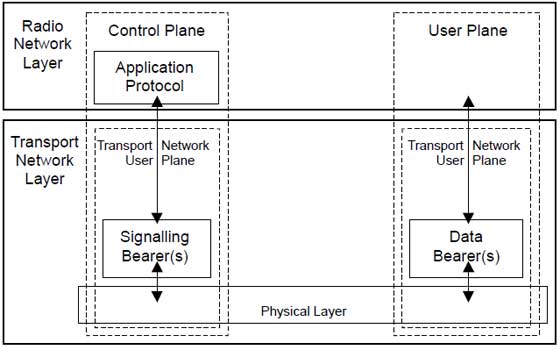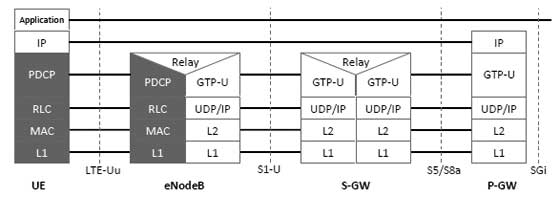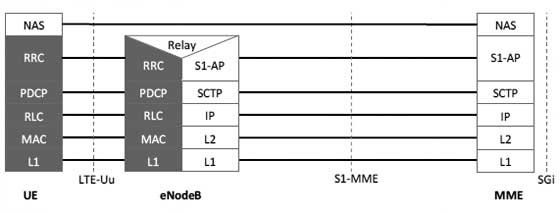LTE Radio Protocol Architecture
The radio protocol architecture for LTE can be separated into control plane architecture and user plane architecture as shown below:

At user plane side, the application creates data packets that are processed by protocols such as TCP, UDP and IP, while in the control plane, the radio resource control (RRC) protocol writes the signalling messages that are exchanged between the base station and the mobile. In both cases, the information is processed by the packet data convergence protocol (PDCP), the radio link control (RLC) protocol and the medium access control (MAC) protocol, before being passed to the physical layer for transmission.
User Plane
The user plane protocol stack between the e-Node B and UE consists of the following sub-layers:
-
PDCP (Packet Data Convergence Protocol)
-
RLC (radio Link Control)
-
Medium Access Control (MAC)
On the user plane, packets in the core network (EPC) are encapsulated in a specific EPC protocol and tunneled between the P-GW and the eNodeB. Different tunneling protocols are used depending on the interface. GPRS Tunneling Protocol (GTP) is used on the S1 interface between the eNodeB and S-GW and on the S5/S8 interface between the S-GW and P-GW.

Packets received by a layer are called Service Data Unit (SDU) while the packet output of a layer is referred to by Protocol Data Unit (PDU) and IP packets at user plane flow from top to bottom layers.
Control Plane
The control plane includes additionally the Radio Resource Control layer (RRC) which is responsible for configuring the lower layers.
The Control Plane handles radio-specific functionality which depends on the state of the user equipment which includes two states: idle or connected.
| Mode | Description |
|---|---|
| Idle | The user equipment camps on a cell after a cell selection or reselection process where factors like radio link quality, cell status and radio access technology are considered. The UE also monitors a paging channel to detect incoming calls and acquire system information. In this mode, control plane protocols include cell selection and reselection procedures. |
| Connected | The UE supplies the E-UTRAN with downlink channel quality and neighbour cell information to enable the E-UTRAN to select the most suitable cell for the UE. In this case, control plane protocol includes the Radio Link Control (RRC) protocol. |
The protocol stack for the control plane between the UE and MME is shown below. The grey region of the stack indicates the access stratum (AS) protocols. The lower layers perform the same functions as for the user plane with the exception that there is no header compression function for the control plane.























 8937
8937

 被折叠的 条评论
为什么被折叠?
被折叠的 条评论
为什么被折叠?








